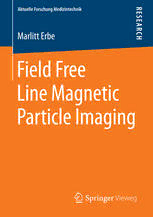
Field Free Line Magnetic Particle Imaging PDF
Preview Field Free Line Magnetic Particle Imaging
Aktuelle Forschung Medizintechnik Editor-in-Chief: Th. M. Buzug, Lübeck, Deutschland Unter den Zukunftstechnologien mit hohem Innovationspotenzial ist die Medizintechnik in Wissenschaft und Wirtschaft hervorragend aufgestellt, erzielt überdurchschnittliche Wachstumsraten und gilt als krisensichere Branche. Wesentliche Trends der Medizin- technik sind die Computerisierung, Miniaturisierung und Molekularisierung. Die Com- puterisierung stellt beispielsweise die Grundlage für die medizinische Bildgebung, Bild- verarbeitung und bildgeführte Chirurgie dar. Die Miniaturisierung spielt bei intelligenten Implantaten, der minimalinvasiven Chirurgie, aber auch bei der Entwicklung von neuen nanostrukturierten Materialien eine wichtige Rolle in der Medizin. Die Molekularisierung ist unter anderem in der regenerativen Medizin, aber auch im Rahmen der sogenannten molekularen Bildgebung ein entscheidender Aspekt. Disziplinen übergreifend sind daher Querschnittstechnologien wie die Nano- und Mikrosystemtechnik, optische Technologien und Softwaresysteme von großem Interesse. Diese Schriftenreihe für herausragende Dissertationen und Habilitationsschriften aus dem Themengebiet Medizintechnik spannt den Bogen vom Klinikingenieurwesen und der Medizinischen Informatik bis hin zur Medizinischen Physik, Biomedizintechnik und Medizinischen Ingenieurwissenschaft. Editor-in-Chief: Prof. Dr. Thorsten M. Buzug Institut für Medizintechnik, Universität zu Lübeck Editorial Board: Prof. Dr. Olaf Dössel Prof. Dr.-Ing. Tim C. Lüth Institut für Biomedizinische Technik, Micro Technology Karlsruhe Institute for Technology and Medical Device Technology, TU München Prof. Dr. Heinz Handels Institut für Medizinische Informatik, Prof. Dr. Dietrich Paulus Universität zu Lübeck Institut für Computervisualistik, Universität Koblenz-Landau Prof. Dr.-Ing. Joachim Hornegger Lehrstuhl für Mustererkennung, Prof. Dr. Bernhard Preim Universität Erlangen-Nürnberg Institut für Simulation und Graphik, Universität Magdeburg Prof. Dr. Marc Kachelrieß German cancer Research Center, Prof. Dr.-Ing. Georg Schmitz Heidelberg Lehrstuhl für Medizintechnik, Universität Bochum Prof. Dr. Edmund Koch, Klinisches Sensoring und Monitoring, TU Dresden Marlitt Erbe Field Free Line Magnetic Particle Imaging Marlitt Erbe University of Lübeck Germany Dissertation University of Lübeck, 2013 ISBN 978-3-658-05336-9 ISBN 978-3-658-05337-6 (eBook) DOI 10.1007/978-3-658-05337-6 Th e Deutsche Nationalbibliothek lists this publication in the Deutsche Nationalbibliografi e; detailed bibliographic data are available in the Internet at http://dnb.d-nb.de. Library of Congress Control Number: 2014933589 Springer Vieweg © Springer Fachmedien Wiesbaden 2014 Th is work is subject to copyright. All rights are reserved by the Publisher, whether the whole or part of the material is concerned, specifi cally the rights of translation, reprinting, reuse of illustrations, recitation, broadcasting, reproduction on microfi lms or in any other physical way, and transmission or information storage and retrieval, electronic adaptation, compu- ter soft ware, or by similar or dissimilar methodology now known or hereaft er developed. Exempted from this legal reservation are brief excerpts in connection with reviews or schol- arly analysis or material supplied specifi cally for the purpose of being entered and executed on a computer system, for exclusive use by the purchaser of the work. Duplication of this publication or parts thereof is permitted only under the provisions of the Copyright Law of the Publisher’s location, in its current version, and permission for use must always be obtained from Springer. Permissions for use may be obtained through RightsLink at the Copyright Clearance Center. Violations are liable to prosecution under the respective Copyright Law. Th e use of general descriptive names, registered names, trademarks, service marks, etc. in this publication does not imply, even in the absence of a specifi c statement, that such names are exempt from the relevant protective laws and regulations and therefore free for general use. While the advice and information in this book are believed to be true and accurate at the date of publication, neither the authors nor the editors nor the publisher can accept any legal re- sponsibility for any errors or omissions that may be made. Th e publisher makes no warranty, express or implied, with respect to the material contained herein. Printed on acid-free paper Springer Vieweg is a brand of Springer DE. Springer DE is part of Springer Science+Business Media. www.springer-vieweg.de Preface by the Series Editor ThebookFieldFreeLineMagneticParticleImagingbyDr. MarlittErbeisthe8th volumeofthenewSpringer-Viewegseriesofexcellentthesesinmedicalengi- neering.ThethesisofDr.Erbehasbeenselectedbyaneditorialboardofhighly recognizedscientistsworkinginthatfield. TheSpringer-ViewegseriesaimstoestablishaforumforMonographsandPro- ceedingsonMedicalEngineering.Theseriespublishesworksthatgiveinsights intothenoveldevelopmentsinthatfield. Prospectiveauthorsmaycontactthe SeriesEditoraboutfuturepublicationswithintheseriesat: Prof. Dr. ThorstenM.Buzug SeriesEditorMedicalEngineering InstituteofMedicalEngineering UniversityofLübeck RatzeburgerAllee160 23562Lübeck Web: www.imt.uni-luebeck.de Email: [email protected] Geleitwort Magnetic-Particle-Imaging ist eine bildgebende Methode, die den Tracer-Ver- fahren zuzuordnen ist. Eine Suspension von Dextran-umhüllten Eisenoxid- basierten Nanopartikeln soll dabei dem Organismus appliziert werden. Die hoch sensitive und echtzeitfähige Abbildung der räumlichen Verteilung der Partikel ist das Ziel der Methode. Dazu wird über eine Maxwellspulenpaar- anordnung zunächst ein Selektionsfeld erzeugt. Der Null-Durchgang des Se- lektionsfeldgradientenwirddannübereinsogenanntesDrive-Fieldperiodisch imRaumverschoben,sodasssicheinegewünschteAbtasttrajektorieergibt,die derSpurdiesesNull-Durchganges(demfeldfreienPunkt-FFP)entspricht.Die ÄnderungderMagnetisierungderNanopartikelwirdübereineEmpfangsspu- leneinrichtungdetektiert. DabeimachtdieNichtlinearitätderMagnetisierung, dieüberdieLangevin-TheorieinersterNäherunggutbeschriebenwerdenkann, dieMessungderMagnetisierungsänderungerstmöglich,dennsieerzeugteine ReihevonOberwellen, dievomanregendenDrive-Fieldnichtüberlagertwer- den. DanichtnurdieMagnetisierungsänderungderPartikelimdirektenFFP- Durchgang,sondernauchdiederPartikeletwasaußerhalbzumEmpfangssig- nalbeitragen,isteineEntfaltungdesSignalserforderlich.WährenddasPrinzip bis hierher einfach zu beschreiben und zu verstehen ist, liegt die Kunst der BildgebungimDetail. AuchdavonberichtetdasvorliegendeBuchvonMarlitt Erbe. SiebeschreibtdiePrinzipiendieserneuenModalitätsehrpräzise,disku- tiert eine alternative Signalkodierung, bei der die Spur des Null-Durchgangs desSelektionsfeldgradientennichteinemPunkt,sonderneinerfeldfreienLinie (FFL) entspricht, und stellt viele Originalbeiträge vor. Gleichzeitig gibt dieses Werk auch eine detaillierte Einführung in das Forschungsgebiet MPI und in viii Geleitwort dieFFL-Bildgebung,dieeinedeutlicheSensitivitätssteigerungimVergleichzu derFFP-BildgebungversprichtunddieMöglichkeiteröffnet,effizienteRadon- basierteRekonstruktionsalgorithmenzunutzen.FrauErbebeschreibtdieInno- vationenimBereichdesFFL-Scanner-DesignsundgibteineEinführungindie unterschiedlichenFFL-Bildgebungstechniken.DasvorliegendeWerkistalsher- ausragend zu beurteilen. Sprachlich schnörkellos reihen sich Originalbeiträge indieserArbeitaneinander. Prof. Dr. ThorstenM.Buzug Acknowledgements TomymentorThorstenBuzugforhisabilitytocreateanenvironmentformeto prosperinscientific,professional,andpersonalregard. TomycolleaguesanddearfriendsTimoSattelandTobiasKnoppfortheircon- stantsupportandthemostdelightfulcollaboration. TothemostdedicatedandbrightstudentsMatthiasWeberandKlaasBente. ToBärbelKratzandAndreasMangfortheirenduringinterpersonalsupport. TotheMPIteamatourinstitutefortheirideasanddedication. TomyparentsHelgaandPeterErbeforkeepingmefromconcerns. ToAnniErbeforbeingatimelessrolemodelofkindness. TomydearfriendsAnnikaandChristinaPagel,SophiaBeuster,andEvaDahlke forkeepingmeopen-minded. TomybrotherJanniErbeforhiswitsandforproof-reading. TomybelovedLeroyJönsson. Abstract Modernmedicineisintrinsicallytiedtotechnology. Notonlymedicaltherapy, butalsomedicaldiagnosticsconsiderablybenefitfromtechnologicalprogress. This connection is impressively demonstrated by the development of medical imagingtechnologies,whichhaverevolutionizedacountlessnumberofmedi- calapplications. Sincetheveryfirstx-rayimageswereproducedin1895[R9¨8], itwasnotuntilthe1960sand1970sthatthepowerfulmedicalimagingtechnolo- giescomputedtomography(CT)andmagneticresonanceimaging(MRI)were introduced[Lau73,Hou73,Cor63,Cor64]. Sincethosefirststeps,groundbreak- ingprogressinspatialandtemporalresolutionaswellasdoseissueshavebeen achieved. CTofferssliceimagesofthehumanbodywiththeuseofx-rayradi- ation[Buz08]. WhileinCTahighspatialandtemporalresolutionisachieved, the disadvantage of this method is the exposure of the patient and the physi- ciantoionizingradiation. MRIincontrast,workswithouttheneedofionizing radiation,butsuffersfrompoortemporalresolution. In2005,B.GleichandJ.Weizeneckerintroducedanovelmedicalimagingtech- nology called magnetic particle imaging (MPI) [GW05], which combines high spatialandtemporalresolutionwithabdicationofharmfulradiation. MPIim- ages the distribution of a superparamagnetic iron oxide (SPIO) nanoparticle tracermaterialwithinapatient.Itintrinsicallyprovidesthreedimensional(3D) data with a sub-millimeter resolution and is capable of performing real-time imaging. In the very first in-vivo MPI experiments, 3D images of a beating mouseheartwereproduced[WGR+09]demonstratingthepotentialheldbythis fascinatingnewtomographicmethodtoconsiderablyimproveimagingoffast blood-flowphenomena.
